Matador Network's Blog, page 2171
December 19, 2014
7 life lessons of snowboarding
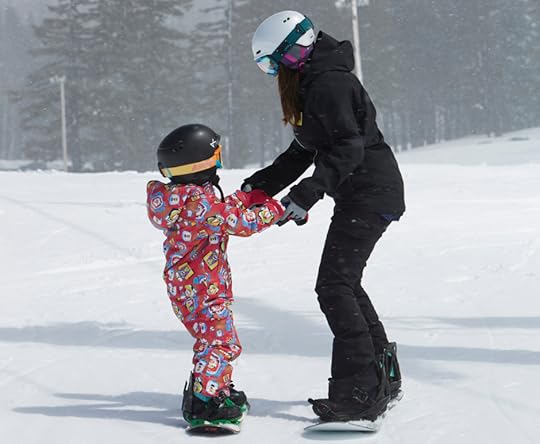
Photo courtesy of Burton: Learn to Ride
I grew up in the South and didn’t make it up to a real ski mountain (Crystal, in Washington) until my freshman year in college. But in a way that late start was a gift. Falling in love almost immediately, I started making up for lost time by moving west, working at a ski resort, and getting used to 40+ days on the slopes (that’s more like it!). Whole seasons of riding.
This had a deep effect on my life. Over the past 15 years I’ve lived in different places (the Front Range, Seattle, Patagonia), all of which had their own entry points to otherworldly realms.
As with everything else that gives profound access to a certain part of the world (surfing, paddling), being on the mountain becomes less a “sport” than a way of life. Although it starts with the body, the muscles, the clumsy motions you make learning to turn, what you learn to exercise the most on the mountain (or in the river, the ocean) is your mind. When you get good enough, you see lines, openings, possibilities where other people only see “scenery.” And this is perhaps the ultimate life lesson of those days you spend on the hill — you build a relationship, an appreciation for the place itself.
Whether you’re considering bringing your family to a ski area or you’ve already raised a pack of rippers, here are some life lessons from the hill — both philosophical and practical.
1. Start early.
This lesson permeates every level:
Start learning early: You’ll be further along your progression at a younger age.
Start your day early: You’ll get the best conditions, the untracked pow.
Start your turns early: Initiate your turns way ahead of when you think you need to. The steeper the terrain, the earlier you need to start.
2. Give respect, get respect.
Q: Who is the the best rider on the mountain?
A: The one having the most fun.
People who are aware — aware of their abilities, aware of the conditions, aware of other riders / skiers on the hill — are the ones who give and get respect. The ones who are stoked. Riding terrain beyond your ability, or flailing, bulldozing big swaths of pow, getting in the way of other riders — this is how you lose respect on the mountain, and in life. More on this below.
3. The greatest playground is outside.
It’s weird speaking from this side of the generation gap, but as a kid in the ’80s and ’90s we were always outside. After school it was neighborhood BMX bikes or skateboarding or hoops or soccer. This still seems the case when I travel in Latin America, but somehow it’s changed here in the US. Where are all the kids? Everyone stays inside.
Being on the mountain, with the endless ramps and berms and waves and glades, being able to carve turns through that realm, to float above it on lifts — it’s a pretty rad playground. Feeling your legs burning, your fitness level tested, your breathing pushed to the limit…a good day on the mountain teaches your kids that being outside all day doing something super fun makes you strong, healthy. It makes you feel incredible. Compare that with how you feel after five hours of looking at a screen.
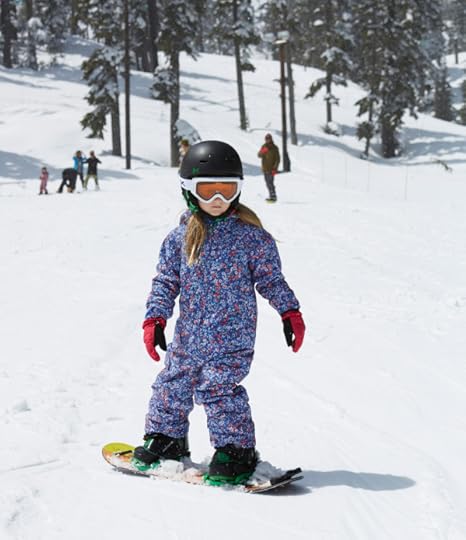
Photo courtesy of Burton: Learn to Ride
4. You don’t just wake up good at something.
And speaking of screens, kids growing up right now are used to immediacy. Every conceivable piece of information or music / movie / TV / media selection is instantly available via the internet. There’s also just the good old cultural conditioning we’ve grown up with here in the US that says to get things done NOW.
The mountain offers a different lesson. It rewards patience. Not just an external — “dang I wish this lift-line would move faster” — patience, but the internal patience that underpins your progression as a skier or snowboarder. Your kids may be fast learners. Or they may get frustrated easily. Either way, help them understand that their time on the mountain is its own reward. No fall is wasted — that’s how you get better. You don’t wake up good at it. You have to pay your dues.
5. Certain things you can’t fake.
Whether it’s a peeling ocean wave or a snowy glade, water is a perfect mirror. It reveals your exact level of skills and control. It shows to the exact degree whether you’re riding something beyond your ability. It reflects your timidity or aggression, your creative potential with the terrain and conditions.
And what’s especially cool about the mountain is that for a brief while, you leave a record of all this for everyone to see — your lines there on the snow. As you ride back up the lift, you can see exactly the arc of your turns, the places where you sprayed powder, or aired over a gap. The places you faceplanted. The lesson: Own your progression. Ride the terrain that you can style before moving on to a situation where you’re out of control. The mountain will always call your bluff. Life tends to be the same way, right?
6. Your lines only last a second.
The whole reason it’s cool to see your lines serpentining down the slope is that they’re impermanent. Within a few days they’ll be snowed over or slashed to pieces by a thousand other riders. And eventually they’ll all join the same rushing meltwater that if you’re lucky you’ll be paddling / surfing in your kayak!
The lesson is to be spontaneous. To go for it. While learning on mountain (and in life) seems to reward patience and control — well thought- and planned-out lines — the true breakthrough moments come when we make unexpected spontaneous moves.
7. Appreciate the good days and places.
So much of our attention gets sucked up by our workdays, our routines. Think it’s any different for our kids? How many hours a day do they sit at desks? How many of their potential adventures go unrealized each season?
Our lives tend to become so insulated that we forget the world is a big and very rad place. Just the scale of the ridge as you approach has an effect. As does the ceremony of getting the gear together, of checking conditions, of looking at the trail map, of talking about the runs and lines. The whole process of moving out of the normal everyday routine to a day on the mountain can be a massively important lessons to your kids that, every now and then, you have to hit the reset button. To appreciate being out there as much as you can. 

This post is proudly produced in partnership with our friends at Dick’s Sporting Goods and Burton.
Find the 2014-15 Burton Peak Hoodie exclusively at Dick’s

Memories of the Irish countryside

Photo: Greg Clarke
1. Mass was a place to be seen.
Going to mass was just another social outing for those of us from the countryside. Missing the weekly pilgrimage to Sunday mass was not to be heard in your household, because then it would have the other families gossiping. You and your siblings would have a great time messing, while your parents prayed as hard as they could for the Lord to grant them at least one lotto win, even the local parish one!
As the years progressed, you’d hope to make eye contact with the girl you fancied. Every last minute of your attendance would have to be perfect, from your genuflection to your walk up to the altar for communion. You’d leave mass hoping she noticed, and maybe she’d be stopping at the filling station for sweets too!
2. You shared teachers with other classes.
Depending on how country your hometown was, chances are your primary school was the size of a chicken coop filled with demonic children. Consequently the teacher-per-child ratio was abysmal, which led Miss O’Hagan to jump from 4th classes’ lesson on Ancient Egypt to singing “Let’s Pull Together” with the puberty-bound 6th-class students, guaranteeing you the sort of well-rounded education only denominational schools can!
3. You were involved in many Townies vs. Culchies debates.
Dubliners would class any person abiding in a county other than their own as “culchies.” Rural Ireland then subdivided that into those who live “where mammy does the shopping” as “townies” and those who have an acre of empty field within walking distance of their home as “culchies.” The two groups made fitting rivals in all kinds of sporting contests, with tempers flaring over who was the undoubted ruler of The Pale!
4. You learnt how to drive on the worst possible roads.
Unimaginable bends, narrow spacing, potholes, and wandering elderly pedestrians were just a few of the hazards you had to cope with while taking your licence. While you’re stuck in traffic on the way to the office this morning, think back nostalgically of being stuck behind two types of tractor drivers: those that would move Heaven and Earth to allow you to pass, or the Gandalfs of the road who would take unashamed pride in keeping you stuck behind them until the nearest turn four miles away!
5. You had the parish priest come in to pray for big GAA games.
The definition of “big game” went anywhere from an under-14 blitz to a Minor A Championship Final. All your hard work and dedication comes down to the biggest 60 minutes of your teenage life. The coaches in charge of all this preparation needed something to tip the scale in your team’s favour and have asked Father Cleary to come in and offer a prayer to God. The Big Man has hung up on the elderly clinging to life and convicts on death row because something more important has popped up. It’s about time God picked a side, because even the local butcher had to decide what colour flag to hang on his shop window!
6. Mitching school was rarely successful.
Dossing off school became a real possibility when you realised that you were surrounded by miles upon miles of empty fields. With the vast countryside at your disposal, there was no way you could ever get caught. Unfortunately there was always one teacher assigned to hunting down those who strayed and bringing them to the principal’s office like a dog goes to the pound. You may have missed the entire term’s worth of lessons on guerrilla warfare tactics in history, but you did make it in to watch The Wind that Shakes the Barley, so now you possess everything you need to know to remain undetected in the Irish wilderness.
7. “Down the field” was your favourite venue.
Fights, underage drinking, teenage angst-driven sexual activity all took place “down the field.” You may consider this to be an ambiguous location, but anyone who grew up in the countryside knows exactly where you were talking about.
8. Imagination ruled.
Before playgrounds started popping up in every corner of Ireland, you and your friends had absolutely nothing around to entertain yourselves, but this didn’t stop you from having an incredible childhood. You used your imagination to create castles from heaps of rolled hay or you went exploring every inch of the canal walkways. You and your friends were The Hardy Boys of the Parish!
9. Going to another county town for a “day out” was your idea of a treat.
The 25-minute train journey to Athlone was all you and your friends needed to know you made it in this world at the tender age of 15. Wandering the streets of this foreign town, you would finally see your destination on the horizon; for the space of a single day you’d spend your hard-earned pocket money at the Golden Island Shopping Centre. Splurging all of your cash on slush puppies, accessories from Claire’s, and the odd CD meant that the day out was an astounding success. Reading the liner notes on the journey home filled you with longing for the next time the bus driver stopped at Liffey Valley on your next school excursion! 
December 18, 2014
What Obama’s Cuban deal means
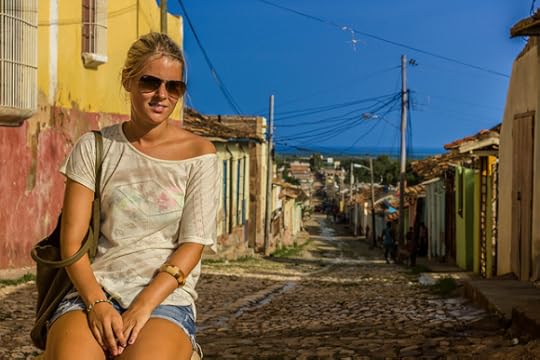
Photo: Christopher L.
Yesterday, December 17, American President Barack Obama and Cuban President Raúl Castro announced a major thaw in relations between the two countries. Full diplomatic relations have been restored for the first time since 1960, prisoners exchanged, and Obama used executive authority to significantly weaken the US trade embargo on Cuba.
Here’s what it all means for American travelers:
A safe haven
The United States will open a full-fledged embassy in Havana. Since enacting the embargo, the American presence in Cuba was limited to a US Special Interests Section in Havana. Originally staffed by Swiss diplomats, the section has been manned by a small Foreign Service detachment since the late 1970s. It offered regular embassy-like administrative support for Americans in Cubans, like replacing lost passports and calling home, but had little direct contact with the Cuban government, often relying on third-party countries to act as intermediaries. A proper embassy will offer greater resources for travelers in need in the event of a natural disaster, social unrest, etc.
Easier entry
The United States will ease restrictions across 12 travel categories, including: family visits, official visits, journalistic, professional, educational and religious activities, and public performances. Ordinary tourism, however, remains strictly verboten. That said, enforcement of the tourism restriction, already noticeably lax under the Obama administration, will likely become an even lower priority for Treasury Department agents.
Charge it
Americans will now be able to use debit and credit cards and travelers’ checks in Cuba. American banks were banned from fulfilling transactions originating in Cuba, so American travelers had to rely solely on cash. To further avoid Treasury Department detection, unsanctioned travelers were smart to first exchange cash in a third-party country like Canada, Mexico, or Jamaica en route to Cuba before then trading that cash for Cuban pesos. Much of Cuba’s private business sector, of course, won’t be immediately ready to accept plastic.
Smoke ‘em if you got ‘em
Americans can now import up to $400 worth of goods from Cuba, including up to $100 in tobacco and alcohol products. Cigar-loving travelers no longer have to worry about “smuggling” Cuban cigars across the border from Mexico or Canada, as long as they stay under that $100 limit. Though small in quantity, this action opens a legal Cuban cigar market in the US for the first time in over 50 years. Cuban rum will also once again be a hot souvenir item. Cuba invented the mojito and the daiquiri — their rum is some of the best in the world.
The next Cancun?
Perhaps the most important takeaway from this policy change is that American travelers should get to Cuba sooner rather than later. It’s only a matter of time before the embargo is completely lifted and Cuba’s white-sand beaches, rainforest-clad mountains, and colonial time-capsule cities are inundated with tourism infrastructure. That is, more than they already have been developed by Canadian and European companies who’ve gained a tourism toehold on the island, most evident in the all-inclusive resorts of Varadero. 
7 signs you are a global citizen
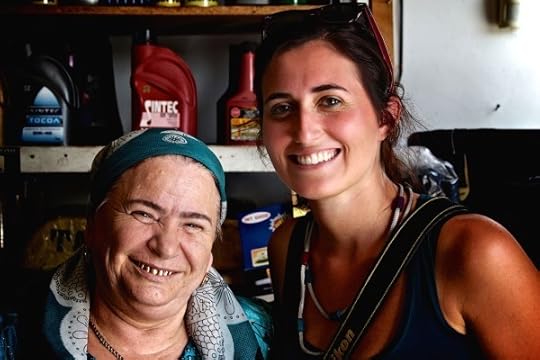
Photo: Jacopo Romei
1. You have a healthy contempt for artificial boundaries.
There’s some truth to the saying that good fences make good neighbors: it’s good to know where you stop and the person next to you begins. But a good global citizen knows that these artificial boundaries are, at the end of the day, artificial, and as a result, can easily be torn down when they wear out their use. While this can refer to national borders (some of which are still pretty damn useful), it can also refer to divides between race, class, nationality, gender, sexual orientation, and even to species. Global citizens know that, at our cores, we are one.
2. You care about people beyond just those around you.
Families and friends are wonderful, but a good global citizen recognizes that she sees from where she stands, and that people standing elsewhere are just as valuable as she. Sometimes, it’s hard to really feel this — it’s much easier to connect with people who are like you, so when someone gets killed who is like you, it may be easier to feel their family’s pain than the mourning relatives of someone else who has been killed on the other side of the world. But a global citizen realizes that just because she may feel this way doesn’t mean that her grief, joy, or anger are any more or less real than the people on the other side of the world.
3. You never stop learning.
Listening is everything. Reading is everything. Learning is everything. It’s more or less impossible to be born worldly. You have to get there through exploring, through empathizing, and through discovering new things.
4. You read news from all over the place.
Global citizens are interested in the world, so they read a lot about the world. But most importantly, they read about the world from other perspectives. If you aren’t looking at the world through as many eyes as possible, you’re not seeing it as clearly as possible. Global citizens also recognize that there’s no such thing as an “unbiased” article; rather, they try to be aware of the article’s bias and keep it in mind when considering what it’s trying to say.
5. You travel.
Travel is essential for getting to know about the world. While you can certainly learn a lot through books, videos, movies, and stories told by others, nothing beats firsthand experience. When you’re in a place for real, stereotypes and prejudices begin to fall apart.
6. You are open to new things.
Global citizens have trained themselves to pause for a moment before judging something that is unfamiliar or uncomfortable to them. They understand that what may be right for them is not necessarily right for everyone else, and they are willing to give someone else’s culture and lifestyle a chance. This also makes them way more fun to be around — they’ll usually try anything that isn’t mortally dangerous at least once, and they’ll always be open to putting new experiences under their belt.
7. You are engaged in politics — particularly regarding human rights and the environment.
You can’t care for the world and not be interested in making it a just, healthy, happy place. Political engagement and debate can be exhausting, difficult, and sometimes even violent, but it ultimately is what changes the world for the better (or for the worse). And it’s easy to find energy for politics when the dignity of your friends on the other side of the globe or the health of the planet you love is at stake. 
Off the beaten path in Morocco
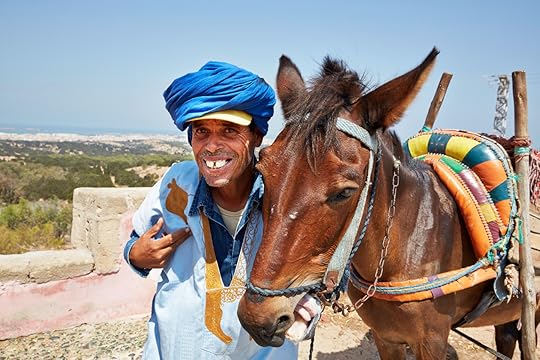
Photo: Marketing Deluxe
Mirleft
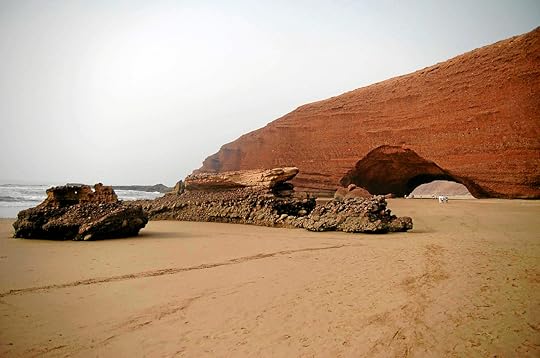
Photo: laurent.paga
While the plush tour buses pull in to ex-hippie-hangout Essauoira, the rattling, once-an-hour public bus takes you down the Atlantic coast to tiny Mirleft. Less than an hour from Tiznit, Mirleft is set in the pebbly red earth just off the coast and has five undeveloped beaches within walking distance.
There’s one bank, one internet café, and not a whole lot to do other than relax.
While wealthy Marrakeshis vacation in beachside landscaped homes, travelers, artists, and everyone else hang around the town’s dirt-road center — when they’re not out sunbathing.
Hotel Atlas is the best bet for backpackers, while touts will offer you plenty of private house rentals.
There are lots of other beaches around Mirleft. Legzira Plage is only a 20-minute bus ride down the road to Sidi Ifni. Females traveling solo especially will appreciate the opportunity to wave-hop and walk amid the sandstone arches in peace.
To reach Mirleft from Tiznit, take either a grand taxi from the medina or a local bus from the main bus station.
Casablanca
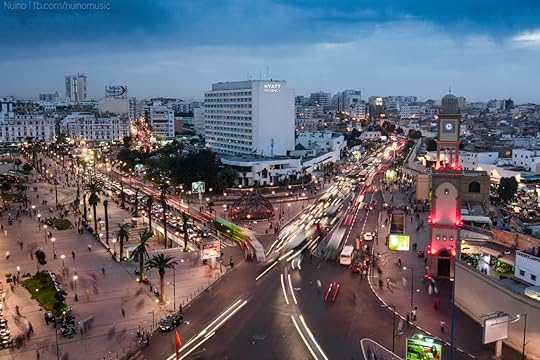
Photo: Hamza Nuino
You won’t hear much good about Casablanca, either from travelers or other Moroccans. Too Western, too big-city, too modern, too poverty-ridden — the sour reputation deters most from anything more than short layovers. Which is what makes Casablanca such a hassle-free destination.
Sure, its wide streets and gleaming new construction don’t lend much historical ambiance, but Casablanca is perhaps the best place to experience modern Morocco.
Sharp-cheeked immigrants shine the shoes of French businessmen, beggars hold out gnarled palms, girls wear tank tops and skinny jeans, and cars honk and careen and somehow don’t collide. Men and women chat over tea and cigarettes at café tables.
The medina lacks touts, shopkeepers ignore you, and no one offers to help when you’re “lost, my friend?”
And then there’s the art galleries, restaurants and, yes, bars. Casablanca may not fulfill any exotic visions, but it does prove that Morocco continues to be a place at the crossroads.
Morocco’s biggest airport is in Casablanca, so there’s a good chance you’ll pass through whether you want to or not. One of Morocco’s few HI youth hostels is located just inside the Old Medina. Eerily empty, it has the cheapest beds in town.
Erg Chigaga/Zagora
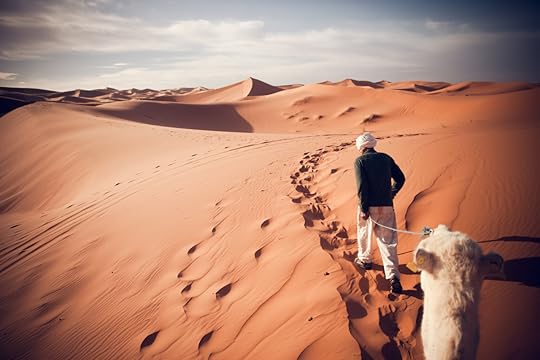
Photo: Chris Ford
Entering dusty Zagora, you pass a sign along its main street that reads: “52 days to Timbuktu.”
Riding a camel into the Sahara is top on most Morocco hit-lists. Convenience sends most tourists to desert Erg Chebbi near Merzouga, but those with a little more time, money, and tolerance for camel saddles head to the sand-swept trading post of Zagora.
Desert caravans have been riding into and out of Zagora for centuries, but these days travelers can arrange Sahara expeditions that aren’t 52 days long.
Numerous outfitters do 4WD and camel expeditions to the isolated, sky-scraper-high dunes of Erg Chigaga.
Avoid the street touts and book with reputable companies like Caravane Desert et Montagne. You’ll get the bonus of staying with nomadic and Berber families during your expedition.
In town, Auberge Jardin Restaurant Chez Ali offers affordable rooms and meals, as well as overnight trips.
Visiting the nearby villages and exploring the Draa Valley is a major plus of basing yourself in Zagora. If you’ve got wheels, check out the organic co-op Hart Chaou community garden project in Agdz, the ancient rock carvings of Timiderte, the jewelers of Amerzou’s old Jewish Kasbah, or the pottery collective of holy village Tamegroute.
First-class bus company CTM operates routes to Zagora from Casablanca via Marrakesh and Ouarzazate, the nearest major city. Smaller bus companies run infrequently to nearby towns; grand taxis are available as well.
Moulay Idriss
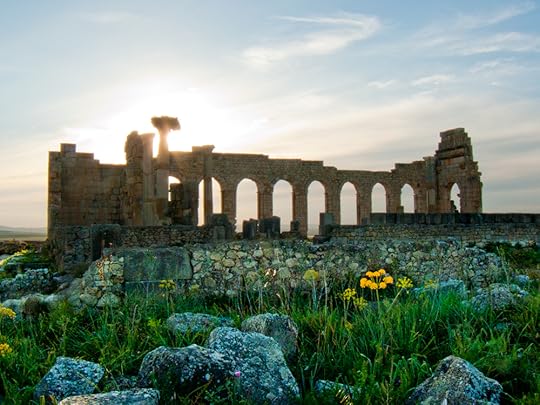
The Roman ruins of Volubilis. Photo: Chico Boomba
Its tumble of white buildings gleams like something pure against dark mountains. Its steep, narrow lanes are lined with cool painted rock, and filled with the movement of donkeys, bread carts, boys playing ball, and schoolgirls who grin shyly before booking it away from you in a bobble of pink backpacks.
Moulay Idriss is one of Morocco’s holiest places — non-Muslims were banned from the small town until the mid-20th century. Tourism has been slow to take off due to this pious reputation and to the town’s proximity to the bigger draws of Meknes and Fez.
That’s not to say it’s unmolested by tourism — a small number of touts hang around the medina entrance, and a colorful array of guesthouse signs describe modern comforts.
But in Moulay Idriss, the greetings (bonjour) you get on the street are less likely to be from a shopkeeper or “new friend”, but rather a smiling passerby.
The surrounding green mountains are great for rural hikes, and any guesthouse will arrange for a guide. Bonus: the vast and under-visited Roman ruins of Volubilis are a 45-minute walk from town.
Frequent grand taxis to Moulay Idriss leave from central Meknes, opposite the Institut Francais. You can book a room ahead at backpacker-friendly Dar Zerhoune, but if you arrive early in the day, arranging a stay at a family-run guesthouse is easy.
Bahalil
Less than 30km away from Fez, this little village is picture-perfect Morocco: slow-paced, traditional, and extremely friendly.
Dar KamalChaoui is a great place to stay for an authentic Moroccan experience. The welcoming staff is helpful and knowledgeable; they will guide you through the village and fill you up on Moroccan culture and local history. Bonus: the food is out-of-this-world delicious.
The troglodyte houses (cave dwellings), painted in pastel colours and located in the old part of the village, are unique and worth a visit.
The town of Sefrou, 6km away, is also a good place to check out.
Rabat

Old mosque in the Chellah necropolis. Photo: Alexandre Baron
Rabat is the capital of Morocco, but, compared to the big city of Casablanca, it combines modernity and traditions beautifully.
The Medina is a great place to shop (and bargain!) for traditional Moroccan items or sit and enjoy a hot drink. Walking around, you’ll be able to witness some of the artisans at work, embroidering carpets or sewing leather shoes.
The ancient ruins and the garden of Chellah are a must-see. Peaceful and filled with history, it’s also a great place to admire storks. I would recommend a visit at the end of the day: the light is amazing and the place looks magical.
Tafraoute/Ameln Valley
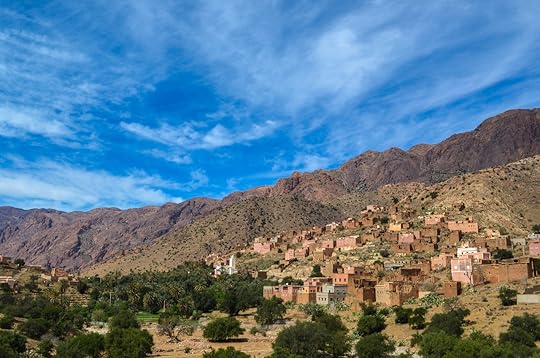
Photo: jbdodane
A lion watches over the sleepy town of Tafraoute.
Or at least that’s what the villagers will tell you, gesturing at one of the distinct rock formations just outside of town that resembles a lion’s face. Another apparently looks like Napoleon’s hat.
Carved into the hills, Tafraoute is an a trekker’s dream. Uber-fit hikers and cyclers are about the only other travelers you’ll see here, largely due to the infrequency of bus service through the Anti-Atlas mountains.
The main attraction of Tafraoute is its immediate access to undeveloped wilderness dotted with Berber and Chlueh tribe villages.
Mountain biking and trekking expeditions take you through the Ameln Valley, up peak Jebel Lekst (2359m), or through the green gorges of Ait Mansour.
For trips closer to town, you can rent a bike from Hotel Salama (also your best bet for lodging), or grab a local trail map from Au Coin des Nomades.
Make sure not to miss the prehistoric rock engravings near neighboring towns Tazekka and Tirnmatmat. Any aches and pains can be sweated away in a local hammam.
Small bus companies operate from Agadir via Tiznit, and there’s limited service to Casablanca and Marrakesh. 
This article was originally published on December 17th, 2014
December 17, 2014
Americans stop caring at Christmas

Photo: Corey Balazowich
1. That Christmas music is flat out annoying as shit
There’s a reason we only listen to “Deck the Halls” for one month out of the entire year. Why we choose to do so on repeat for that entire month is beyond me, but we do. We tune into our local all-holiday music, all-the-time radio station and sing along as Elvis serenades us with his classic rendition of “Silver Bells.”
2. Flights to Florida all of a sudden cost $1,000
It’s Florida, folks. Not Bali or Fiji or even Hawaii. It’s just a bunch of old people and cartoon characters, but if you really want to spend the same amount of money it costs to fly to Australia on the chance of some American sunshine this Christmas, by all means, go ahead. Pack up those swimsuits and join the masses who also paid way too much to escape the cold from Christmas until New Year’s.
3. What happened at Thanksgiving dinner
It’s been several weeks, so let’s all pretend no one remembers the screaming match that left you stranded in the kitchen cooking the turkey all by yourself. Christmas is a new chapter. Time to start fresh and bury any remaining grudges just long enough to collect all the presents coming your way.
4. That little thing called a budget
Pshh. Budgets are for scrooges and grinches, not for us loving, giving Americans. The average shopper spends over $800 on Christmas presents every year. And it might just be me, but that number sounds a little low. With Black Friday now starting earlier and earlier each year, I’m sure we’ve all already surpassed any semblance of a budget we started the season with.
5. How many calories are in an entire pumpkin pie
Let’s be honest, no one diets during the holidays. As mammals, it’s only normal to pack on the pounds and hunker down for the cold-weather months ahead. Bring on the homemade pies and third helpings of candied yams and just add “losing winter weight” to the top of your New Year’s resolutions list like usual.
6. That “it’s the thought that counts”
We’ve all heard grandma quietly utter those words from behind a kind smile after we open the hideous homemade jewelry from your crazy aunt (you know the one). And we’ve all immediately disregarded her wisdom as a deeply disgusted look replaces any form of excitement. Let’s be real, it’s not the thought that counts; it’s whether you got me what I wanted or not.
7. Basic manners
Waiting in lines, sold out toys, and hosting the holidays all seem to make us forget the basic Ps and Qs we learned in kindergarten. All the sudden, we have no problem full-on body checking the innocent old lady reaching for whatever this year’s version of the Furbee is (remember those?!).
8. To take only two official days off
Although the government only recognizes Christmas Day and New Year’s Day as federal holidays, we all know that basically the entire month of December is a wash when it comes to work productivity. After Thanksgiving, our brains have officially checked out and started planning for our Christmas celebrations.
9. The first syllable in the name of the holiday
It is “Christ”-mas, as in it is a holiday that celebrates Jesus Christ. Despite this minor detail, atheists and non-Christians alike embrace the traditions of this birthday celebration. No one wants to be left out from receiving a new iPad just because they don’t believe in God. Come on… 
Trains, borders, and a criminal past

Photo: Ben Raynal
Just before eight in the morning on September 6, I caught the Amtrak Adirondack Line at Penn Station, a ten-hour train journey up the Hudson River and the eastern edge of New York State, past Lake Champlain, snaking along a path carved into bluffs so that at times the rest of the train was visible through the windows ahead and behind me on the tracks above the water and the pines.
Destination Canada, Montreal, where I’d never been. I had no other purpose for the trip but to get out of the every day, stir my imagination, do some writing in a new city and country.
At around 6pm that evening, we passed Rouses Point, New York, a sleepy little outpost and the last stop Stateside. Just over the border is the Lacolle Inspection Station, run by the Agence de Services Frontaliers du Canada.
Just as the day’s fantastic light was fading, Canadian border officers in sturdy blue uniforms, with badges and guns, came aboard and began questioning each passenger. The agent nearest me was a short Asian-Canadian woman with glasses and a steady presence.
At a seat two rows in front of me, she thoroughly questioned a young German woman who had a French boyfriend that she’d met in New York where she was studying. She was on her way to visit him in Montreal. I thought of how even an average story could quickly start to sound complex and curious.
Soon this same officer was at my seat. I handed her my passport and customs declaration.
“Hi, what’s the purpose of your trip?”
I told her that I wanted to see Montreal, that I’d always heard good things about it.
“What do you do?”
“I’m a writer and teacher.”
“You’re a teacher?”
“I am.”
“And where are your bags?”
“Just that green one up top and my computer bag here.”
“How many days are you planning to stay?”
I was coming back Tuesday, in three days.
She gave me back my passport. I noted she didn’t stamp it and asked her for one.
“We usually don’t do it for Americans.”
“Really? I just like to have the record of the trip,” I tried pleasantly.
“I’ll come back when I finish the rest of the train,” she said.
But she didn’t want to stamp my passport, I soon learned, because they weren’t done with me yet. In fact, they’d been waiting for me.
“Come with us with your bags,” she told me, returning to my seat with another officer.
I thought about her questions from just before, my answers, as if I’d failed an exam. “I just want to see Montreal.” Did that sound like a line?
I saw only one other passenger on the packed train who’d been singled out, a young, tall, innocent-looking Asian guy. He was sitting in the main room of the border post, which was connected to the train platform by a white metal staircase and ramp.
There were two other female officers there, along with a male officer who had the aspect of a Canadian Bruce Willis, like John McClane, with a pleasingly shaped shaved head and a soft face. They led me into a back room. The entire station antiseptically clean, white, and bare.
I placed my two bags on the white table, sat down, and Officer Willis made a calm search through them. Then he sat down, crossing his legs. The officer who’d first questioned me on the train — Officer Karen, I’ll call her — stood across the table from me holding a sheet of paper. The train waited.
“Do you know why we pulled you off?” she asked me.
I was beginning to think I did.
“Have you ever been convicted of a crime?” she asked.
“Yes,” I said a bit painfully after a pause. “Twenty years ago I served three-and-a-half years in prison for a felony drug conviction in South Korea.”
Neither she nor Willis reacted to this—because evidently this is what they already knew and what was printed on the page Officer Karen held in her hands. She seemed to be checking this summary off as I recalled it.
“What drug?” she continued.
“Hashish. It was a reckless decision and I learned a hard lesson.” That was 1994, when I was 23. “I wrote my first book about it. I would never jeopardize myself like that again.”
Willis raised his eyebrows and nodded his head in a way that seemed to convey his sympathy or understanding. Other times he squinted at me trying to take my measure.
“Okay, but because of this you may be inadmissible,” Officer Karen leveled with me. “We may not be able to let you in.”
I was stunned, hadn’t anticipated this.
It’s not that I didn’t know that a crime, a conviction, and prison term, can follow one detrimentally forever, a collateral punishment often without end. But unlike most ex-cons I have little to complain about. My offense occurred on the other side of the world. As far as I know, the US State Department has a record of my incarceration, but it’s shielded by a privacy act that requires my consent. But then, as a writer, I’ve willingly told this story publicly.
I’ve traveled since serving my sentence, after which I was deported from South Korea and arrived back in New York, in 1997. On my trips afterward, that record had never come up, at either US or foreign customs. But of course it’s often enough been in the back of my mind: Do these authorities know or care? Will they trouble me over it? What restrictions could I face?
I went to Jamaica (of all places) for a friend’s wedding in 2000, and to Spain in 2001. Nothing, not a word about my prior offense. Those trips were pre-9/11, a different world of course. But I returned to Spain, the Canary Islands, for a story in 2008, and to England that same year. Again, not a word about my conviction was said to me by customs or any state authority either here or there.
“What were you charged with in Korea?” Officer Karen asked me.
“Possession, usage, and importation.”
No way they’re letting me in, I thought. Barred from Canada! I considered the lost money, the lost opportunity to finally visit Montreal, this harmless journey I’d planned to our friendly northern neighbor. And the train ride had been so beautiful, dazzling outside the windows.
“It’s good you were honest with us,” Willis said from his chair. “Lying to a border officer is automatic grounds for not letting you in.”
He mentioned that they prescreen all train and bus passengers. I’d set off their incoming radar.
“Is there anything else? Something more recent?” Officer Karen pressed on, standing firm on her side of the table.
I couldn’t believe it. They must know.
“Yes,” I said again, somewhat painfully, knowing that these facts could look distorted without context, how easy it is to judge a person for one part.
“In New York City I was arrested in February for having a smoke on the street. I was watching the NBA All-Star game, stepped outside just to have a smoke.”
No way they’re letting me in.
The reason I was cuffed and arrested then and not just given a small fine, had to see a judge the next day, was because I had a warrant out on an unpaid summons from 11 years before. That summons was for drinking a beer in a brown paper bag at the 4th Avenue subway stop in Park Slope, Brooklyn, when it had more grit. I sound like a lawbreaker, I was thinking (still now as I write), but it’s such an incomplete picture.
“How much marijuana did you have?” Officer Karen asked.
“A couple of grams.” I should have paid that summons; that was all on me, a trace of my anti-authoritarianism — a fury that prison fired — for which again I lost and paid, my night in the holding cell in the NYPD Midtown South Precinct a horror show, a sleepless night in squalor worse than I experienced in Korea 20 years before. But that’s another story.
“A couple? How many?” Officer Karen pressed.
“Two or three.”
“Two or three?”
“I don’t know. About that much. It was just a little bit,” I said, for the first time frustration creeping into my voice.
I reminded myself again that I was not presently in violation of the law. I was clean. This was all from my past, but it had outraced me here to the Canadian border.
“Because these offenses are related there may be a problem,” Officer Karen continued.
“I understand,” I said, recovering. “I respect what you do.”
“I’ll be back,” she said, leaving me with Willis.
What about other countries, will they let me in now or bar me too? What did this mean for my travel dreams, my freedom to come and go in the world?
I didn’t know it yet, but the day before, on September 5, The New York Times had published an article detailing the story of the rise and fall of the biggest marijuana trafficker in New York City history. One Jimmy Cournoyer, a French Canadian from Montreal, who had used that city as a staging ground for his operation, and the Canadian-New York border south of Montreal — not far from the very spot where I was then being interrogated — as a major conduit for his weed.
Whether this was a factor in my experience at the border, whether the officers even knew of the case or had it in mind, I can’t say.
In addition to the massive Cournoyer case, the New York-Canadian border has seen some other notable recent action: those AWOL Afghan soldiers training here who tried to flee into Canada at Niagara Falls; the Canadian woman caught at JFK with guns and pounds of pot.
I was thinking all is lost. Despite being in complete present compliance, I was persona non grata mainly due to a bad choice I’d made 20 years before, one for which I’d already paid a substantial price, my debt to society.
“My chances don’t seem good at all,” I commented to Willis.
“Hard to say. Let’s see,” he said, giving away nothing.
I asked him what was to happen to me if they turned me away.
“I can drop you off in the nearest town.” He meant on the New York side.
“And I just have to find my way from there?”
“I think Amtrak has a deal with the bus company.” But it was almost night now and when did the bus run and…I began to resolve myself to it. All I can do is roll with this, I thought. Let me face what comes.
Then Willis told me the story of a Canadian woman recently turned away at that same border crossing by American customs because she had on her record a shoplifting offense committed in the US more than thirty years earlier.
“They didn’t let her in, because what she took was worth a few hundred dollars. Her husband and the kids went ahead to Florida without her.”
Willis told me that he drove the woman back home, on the Canadian side.
“That was nice of you,” I said. He nodded. “She must have been distraught.”
“Oh, yeah. She was crying the whole way.”
Barring her was extreme and unnecessary, I offered. Willis raised his eyebrows and gently nodded. I liked him but wondered, Is he telling me this to say there’s no chance for me?
I thought about the tit for tat that can be part of these border affairs—our biometric requirements that provoked other nations to adopt the same, spitefully in some cases; diplomatic rows over individuals.
The prospect of being barred and turned away from Canada was certainly a shock to me, a disappointment, but I was already thinking about the larger ramifications, too. What about other countries, will they let me in now or bar me too? What did this mean for my travel dreams, my freedom to come and go in the world? Any curtailment of that would be the worst consequence of all.
“It’s amazing how this still haunts me,” I said to Willis, as we sat there waiting for my fate. “Even though I served my punishment, I’m still paying for it.” He nodded slowly in what I saw as understanding.
Finally, Officer Karen came back, still holding that paper in front of her.
“Was it a kilo?” she asked me. “How much was the conviction for in Korea?”
“Why, does that help my chances?” I answered. It felt surreal to be scrutinizing this distant story from what felt like another life. “In fact it was less than a kilo,” I went on. “It was 930 grams. The Filipinos I bought it from had short-changed me. The only reason I knew that was because it came up in court. They’d weighed it.”
“Can you show us something that proves it?” Officer Karen asked me. “Because the quantity matters in terms of our rules for admission.”
“I think so. I have documents on my computer.”
She left the room again and I took out my laptop and opened it. Rattled, hands a bit shaky, I searched for those files, any related to the case, but couldn’t in that moment recall what I’d titled them, not for the life of me. I knew I had scans of my original charge papers, in their forbidding Korean, which I couldn’t understand at the time, twenty years ago.
I mentioned that I felt bad holding up the entire train. Willis nodded again in commiseration.
I couldn’t find anything with the detail they wanted, despite all the files, the press, and related material on my computer. My mind was a blur. I was failing in the crucial moment. So be it, I thought.
Then Officer Karen returned again. “Here’s your passport,” she said. “We found something that proved what you were telling us.”
Inside it was stamped, a leafy oval: Canada Border Services Agency, Lacolle Station.
“Next time you should bring court papers,” she advised me.
What I need to do is travel with copies of my prison book, I thought, to have ready if necessary, physical evidence that I’m a writer and not a smuggler—my book a kind of preemptive moral calling card, complete with my remorse and regret, my appreciation for the harrowing experience.
There is a delicate, constant balance needed between strength and intelligence, freedom and security, civil rights and the law—these scales of opposing tensions, in individuals as in our institutions.
Willis and Officer Karen were balanced and fair with me. They didn’t threaten or condescend. Not for a moment did they act morally superior. I feel good knowing they’re out there doing this work, in the way they dealt with me.
“You’re free to go,” Officer Karen told me.
“Thank you, thank you,” I told them happily as I snatched up my bags and headed out of the room. Willis was now standing against the wall just outside the door. “Sir,” I said, throwing out my hand to him. We shook.
Officer Karen was by the computer in the main room where they must have Googled me. “Ma’am.” I shook her hand.
“Let them know that we’re finished,” she said. “The train can go.”
I scrambled back up the stairs and on board. Montreal awaited. Other passengers looked at me as I settled into my same seat and felt relief wash over me.
“You all right?” a young Amtrak attendant asked me playfully. “What happened?”
“It’s a long story,” I told him.
A Canadian couple from Toronto, who had just spent a wonderful week in New York City, their first visit, were in the seat in front of me. As I sat behind them breathing with new life, the grey-haired wife in jeans got up, leaned over, and whispered in my ear, “Did they strip search you?”
“No, thank goodness.”
“Sometimes they give Americans a real hard time.”
Not this traveler, I thought. 
How not to be a tourist in Paris

Photo: IAmNotUnique
AS AN American-tourist-turned-bona-fide-Parisian, I have learnt, at my expense, how to blend in while wandering the French capital. Here are a few tips to help you go incognito in Paris:
1. Stop taking selfies with the Eiffel tower. Now.
If you really have to, take one. Five if you’re worried about getting a good angle. But there’s no excuse for taking 500.
2. Stop smiling at strangers.
They’re getting freaked out.
3. Think again about putting that lock on the Pont des Arts.
First of all, it’s a security risk because the weight of all those locks makes the bridge dangerously unstable. Second of all, hate to break it to you, but city workers cut off your sign of everlasting love because of said security issue.
4. Realize that “Bon matin” doesn’t exist in French.
It’s just plain old bonjour until it’s bonsoir.
5. Avoid moving around in large herds.
Hit the town solo and you’ll definitely discover more because you’ll be open to the city around you.
6. Don’t waste your precious time waiting in line at Ladurée.
I mean, it is pretty and so are their macarons. But it’s a lot more fun to wander into unknown little bakeries where you don’t have to wait in line.
7. Be considerate when you stop people for directions or ask them to take your photo.
I can’t tell you how often tourists jump in front of me while I’m running to ask me long questions about which direction to go in or to get me to take their picture. One man literally blocked my way and shoved his camera in my face. Once, I was running before 7am on a workday and two separate groups of tourists stopped me for directions. I’m sorry, but the sweaty girl hurtling along at 6:45am probably does not have time to answer your questions.
8. Don’t be too sad when you see the Moulin Rouge is just a seedy tourist trap.
I know, I love that movie, too.
9. Don’t bring up old tired stereotypes about French people.
Guaranteed you are NOT going home with that sexy Parisian girl if you ask her if she shaves her armpits, wears deodorant, or is reeeeeeaaaallly into sex like all French people.
10. Remember that not all people in Paris are tourists.
Sounds silly but people have some funny ideas about life in Paris. Just because I live here doesn’t mean that I spend all day making out with Parisian men on benches, drinking wine, and having long lunches. I actually work and have to go to the grocery store and have nights where I am too tired to go out, like every other Parisian.
11. Avoid St. Germain-des-Prés.
I find it expensive and empty. I also see practically no real Parisians there.
12. Skip St. Michel and the Île St. Louis.
These places are just writhing with tourists. St. Michel is like a very fake, very rowdy little tourist fairyland. Île St. Louis is quieter and more expensive, but for me, it just isn’t Paris.
13. Swap the French onion soup for some Moroccan tagine or some Senegalese mafé.
Paris is a world city and is home to waves of immigrants from all over the world. I definitely recommend that you enjoy the traditional French bakeries and whatnot but on, at least, one of your nights you should consider swapping some “French food” for some food brought to you by multicultural France. And remember that France isn’t just whitewashed Amélie, as cute as she is.
14. Don’t pause in the middle of a passageway to look at a map or your iPhone…unless you want to make enemies.
Especially in Paris, where some sidewalks are so small you just can’t pass someone trying to find the Eiffel Tower. (Hint, look up.)
15. Know that anyone wearing Paris and / or Eiffel Tower paraphernalia is the embodiment of the cliché tourist.
16. Make your list bigger than the usual Eiffel Tower, Notre Dame, St. Michel, Île St. Louis, Sacré-Coeur, Mona Lisa.
Go wander through the fairytale land of Buttes Chaumont, Parc Monceau, or Parc Montsouris (or countless others). Check out some of Paris’ vibrant, multicultural neighbourhoods (I love the 11th, 12th and 20th arrondissements). Go to the Louvre, but then check out some museums that aren’t the Louvre. 
25 ways to know you're a line cook

Photo: Two Big Paws
1. You know what lowboy, walk-in, reach-in, range, flat-top, six and / or nine pan, and grill brick refer to.
2. You also know that burger, fish tub, hotel (half, two-inch, or four), yogurt, all day, and fire mean something completely different than what most people think.
3. You never have to pay a cover charge or stand in line at a bar because you (and your fellow cooks) are the only ones there on a Monday or Tuesday night.
4. You smell like food constantly. Your hair, hands, clothes, underwear, everything. There is no way around it.
5. And it’s unfortunate, because sometimes you are just too tired to shower. After all, four consecutive days of 12-hour shifts, all of which end after midnight, can be pretty exhausting.
6. But that won’t stop you from going out post-shift. The only social life you can really maintain is one with fellow cooks, so you can’t really afford to pass up their offer to hang out at the nearest bar until last call, can you?
7. On that rare night off, you usually go out to eat at another restaurant. At which point, you order one of everything on the menu, but then they send you triple that because they know you or someone in your group of cooks.
8. And it’s a good thing, too, because you never have any money. You need all the help you can get.
9. You get burned so frequently that you have come to realize it’s more important to get an order out than it is to take off the glove that is currently melting to your skin. That’s also why you have scars all along your hands and forearms.
10. In fact, getting high-quality orders out with impressive ticket times has become your number one priority in life. No spill, burn, cut, or otherwise will keep you from accomplishing that task.
11. You bike to work. It’s cheap, it’s sometimes the only exercise you can get, and everyone else at work does it.
12. You have come to realize Crocs are actually comfortable, and are the perfect no slip.
13. You have an array of baseball hats and bandanas in your closet because you can never have too many hair restraints.
14. You know what it feels like to wear long pants in the summer…while working over a 130° stove.
15. You never go to a restaurant within an hour of closing because you hate when guests do that to you…
16. Usually because you have already started breaking down your station an hour before the restaurant actually closes.
17. You’ve started using kitchen talk in everyday life. No matter how hard you try, you can’t stop telling people at the grocery store when you’re behind them, or acknowledging that you understand something with the ever useful “heard.”
18. You love eating staff meal, but you hate making it because it always puts you in the weeds.
19. You understand the unimaginable stress associated with being in the weeds.
20. You hate the people who order during a rush. You know it’s unreasonable, but you can’t help it.
21. The people in Front of House might be your friends once a shift is over, but during service they are simply the people that keep asking you for more food. And keep complaining when that food isn’t out in a timely fashion.
22. You understand the pit that forms in your stomach when your “all-day” reaches a number greater than five.
23. You are well versed in the art of cleaning the floor. And the counter. And the flat top. And just about anything else you can possibly clean in a kitchen. You also know that, if you have time to lean, you have time to clean.
24. You drink Fernet and Pickle Backs because that’s what everyone else in the industry drinks.
25. You don’t complain much because the person next to you is in the same hot, sweaty, tired boat. And they will be tomorrow, too. And the next day. And on most holidays and weekends. 
20 Arizona facts you may not know
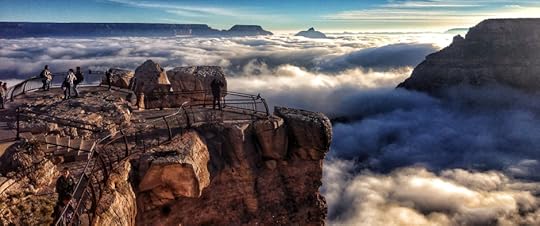
Photo: Grand Canyon National Park
1. There are no giant sand dunes in Arizona.
This is the Sonoran Desert, not the Sahara. And according to some climatologists, it’s the wettest desert in the world. Receiving between 3 and 20 inches of rain annually, the Sonoran is the ideal habitat for hundreds of bird varieties, 100 kinds of reptiles, and 2,000 species of plants. It’s also the only place on the planet where the iconic saguaro cactus grows.
2. Cutting down a saguaro is illegal.
Speaking of that iconic green giant with the humanoid arms, if you cut one down without a permit — whether on public or private land — you might have to pay a fine of up to $5,000. In some cases, it’ll be considered a felony…and you thought the needles hurt.
3. In Arizona, you can drive from Mexico to Canada in half an hour.
Well, you can drive the ecological equivalent. Just north of Tucson, the Catalina Highway climbs from the desert floor, around 2,500 feet above sea level, to about 9,000 feet. You’ll wind through saguaro-studded hills, semi-arid grassland, junipers, short oaks, and Ponderosa pines before finally ending up in a forest of aspens and Douglas firs. The Santa Catalina Mountains are one of several Arizonan Sky Islands — mountain ranges separated by lowland ‘seas’ of desert.

Read more: 8 incredible natural areas in Arizona you've probably never heard of
4. Oklahoma! was filmed here.
Yep. Aside from the studio shots in California, most of Oklahoma! was filmed in San Rafael Valley in the border country near Nogales. The wind comes sweeping down the desert plain…
5. The “Sunshine State” is a more accurate nickname for Arizona than Florida.
Meteorological statistics don’t lie. Arizona is the sunniest state in the country. (Florida comes in fifth.) Yuma is sunny 90% of the time, and Phoenix and Tucson tie at 85%. No city in Florida even makes the top ten.
6. This is one of the oldest continuously farmed regions on the continent.
The Santa Cruz Valley, stretching northward from the border near Nogales up to Tucson, has been farmed since at least 2000 BCE. Around Phoenix, some of the modern canals follow the same paths that pre-Columbian engineers excavated a millennium ago. Heirloom varieties of maize, squash, and beans, along with mesquite flour and prickly pear fruit, can still be planted, harvested, and eaten today. The farm-to-table movement is alive and well in Arizona.

Photo: Parker Knight
7. There’s wine country here. No, really.
Sonoita, Wilcox, and the Verde Valley between Sedona and Jerome have soil and climate conditions similar to those in parts of the south of France, Spain, and Southeastern Australia. For decades, vintners here have been harvesting the alchemy of sun and terroir.
8. The chimichanga was invented here, not in Mexico.
That deep-fried and celebratory staple of Mexican restaurants across America was invented here, in Tucson. The legendary Monica Flin of El Charro Café — the nation’s oldest continuously run family Mexican restaurant — dropped a “burro” into a large vat of boiling fat by accident. To avoid exposing the ears of nearby children to vulgarity, she transformed the final syllable of a commonly used Mexican curse word into the innocently musical chimichanga. Taste buds have been trumping arteries ever since.
9. Arizona is home to the only venomous lizard in the U.S.
Gila monsters are a protected species, and seeing one of these orange-and-black herptiles is a treat as they’re highly elusive. Don’t panic if you do cross paths — they don’t attack, only chomping down on those who choose to harass them.

Read more: 13 experiences you can only have in Arizona
10. The southernmost ski run in the country is in Arizona.
Near Tucson, on the summit of Mount Lemmon (9,157 feet above sea level), Ski Valley is the southernmost ski run in the United States. Only 1.5 hours north of the Mexican border, on average this mountain receives 180 inches of snow per year. The lift operates in summer as well. Floating among cool evergreens while gazing at the hot desert some 6,500 feet below is a novel experience, to say the least.
11. It’s perhaps the world’s unlikeliest jaguar habitat.
Jaguars? Like, the king of the South American jungle? That’s right — they rove as far as Arizona, which is the northern limit of their habitat. As recently as the 1960s, jaguars were spotted near the Grand Canyon. Today they still roam the Santa Rita Mountains and San Pedro Valley of Southeast Arizona.
12. The sun doesn’t get any bigger than it does here.
Amid the forest of astronomical observatories on the top of Kitt Peak, you’ll find the world’s largest solar telescope. Its 110-foot tower focuses sunlight down a 200-foot-long diagonal light shaft that extends 50 vertical meters into the mountain, reflecting off a series of mirrors to give an 85-centimeter-wide image of the sun.

Photo: Ryan Cadby
13. It’s home to the world’s oldest rodeos.
Prescott, northwest of Phoenix, is home to the world’s oldest rodeo. And a couple hours’ drive away, Payson is home to the world’s oldest continuously operating rodeo. They’ve both been lassoing since the 1880s.
14. It’s a state of many nations.
Native American nations, that is — the 22 sovereign Indian nations cover a quarter of the state’s land area. No other state is as ‘native’ as Arizona. And, after English and Spanish, the Navajo language is the most widely spoken in the state.
15. Your right to remain silent began here.
You know, from crime shows, that phrase “you have the right to remain silent?” The Miranda rule owes its origins to a crime in Phoenix and the subsequent U.S. Supreme Court case — Miranda vs. Arizona — from the 1960s.

Read more: Travel guide to Arizona's coolest small towns
16. Arizona has its own Mesoamerican ballcourts.
Archaeologists have found numerous ballcourts throughout the state. The pre-Columbian cultures in the desert Southwest had trade networks that reached all the way down into the tropics. Macaws — transported alive — may have parroted the words of long-disappeared languages that once echoed among the adobe walls.
17. It’s one of the country’s top producers of nuts.
Want some pecans? You don’t have to go to Georgia or Texas. Arizona is one of the nation’s top producers of the tree-grown treat. Green Valley Pecan Company manages 7,000 acres. And over in Cochise County, Fistiki Farms grows pistachios. If you want to pick your own, here’s a good resource.
18. It’s a hummingbird paradise.
These diminutive aerial acrobats love this state. Seventeen different species have been recorded in Arizona, more than in any other state except for Texas. In some canyons, spotters have seen 14 different varieties in just one day.
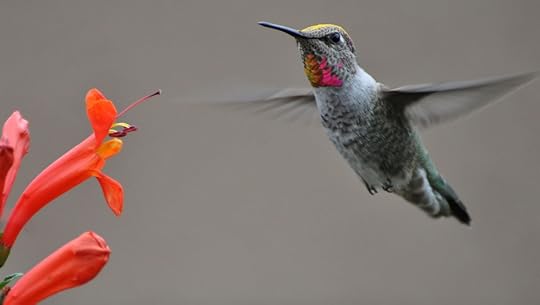
Photo: mark sontok
19. Hawks love it here too. And they hunt…in packs.
Harris hawks, usually associated with their more tropical habitat, have made themselves at home here in Arizona. And these raptors have adapted in a unique way — only in Arizona have they been observed hunting cooperatively, as family groups, in packs…like wolves!
20. The world’s first McDonald’s drive-thru was installed here.
In 1975, soldiers from Fort Huachuca were finally able to rush off base and get a Big Mac on their lunch hour. At the time, they weren’t allowed to leave their vehicles while wearing fatigues, so, at 1802 Fry Boulevard, the McDonald’s in Sierra Vista figured out a way to purvey fried food while respecting uniform rules. Billions have been lovin’ it ever since. 
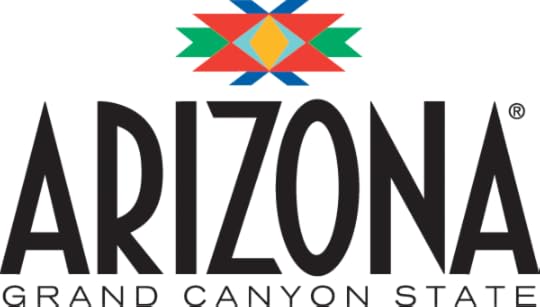
This post is proudly produced in partnership with the Arizona Office of Tourism. Visit their site and start planning your Arizona adventure today.
Matador Network's Blog
- Matador Network's profile
- 6 followers




